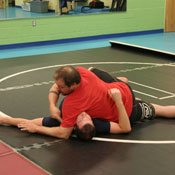Every Monday night at 8 p.m., millions of sports fans tune in to the USA Network to watch World Wrestling Entertainment's "Monday Night Raw." But wrestling is one of the oldest sports known to man and was a legitimate sport long before promoters like Vince McMahon brought larger-than-life characters like Hulk Hogan, The Rock and Triple H to the screen for entertainment purposes.
I was curious about wrestling, which dates back to the ancient Greeks. (It's mentioned in Homer's "Iliad," written in the 8th century BC, set during the Trojan War, and was often practiced naked.) I headed to the Flowood-based Madison Wrestling Club to meet coach Kelly Leo, 36, where I learned that wrestling is a little like human chess: Each contestant is trying to think several moves ahead of his or her opponent.
"The sport of catch wrestling is as safe as any sport can be," Leo says. "Accidents can happen in training, but the goal here is not to injure anyone intentionally."
Thank goodness. Learning catch wrestling, the style Leo teaches, involves a bit of pain, nonetheless. It would have been easy for Leo to hurt me a good bit in his demonstration. But, as he said, if hurting someone is a person's goal, his club is not the place to be.
To demonstrate, Leo put me in arm bars and strangleholds. He also showed me the parts of the human body that can be used as weapons. I learned that a shin bone to the inside of the thigh can be very painful, not to mention how a forearm bone can feel to the jaw, bridge of the nose or eye socket.
Leo became interested in wrestling when he saw a mixed martial-arts event on television. He soon went in search of a school to teach him wrestling and found the MWC, where he's been training for more than four years. Rich Swete started the club in 2005, but he has since moved to Arizona. Leo took over as coach in 2008.
Catch wrestling, also known as catch-as-catch-can wrestling, is a style of folk wrestling that implies "catching (a hold) anywhere you can." This style of wrestling is less restrictive than the Olympic-style Greco-Roman wrestling, which does not allow holds below the waist. It's a forerunner to today's entertainment wrestling and a type of fighting in mixed martial-arts events.
The style originated in traveling carnivals where the carnie's wrestlers would challenge local tough guys to matches for cash and prizes. The old wrestler's lingo is still used today in terms like "hooker," a master at submission holds, and "ripper," someone who will intentionally injure his opponents. Leo and the MWC use these terms as honorific titles to rank fighters.
Catch wrestlers win their matches through submission (when the opponent yields) or pins (where a fighter holds an opponent's shoulders to the mat). Most matches are won through the best two of three falls. No shoes are allowed on the mat, I quickly learned.
"Everyone on their first visit to the club does not know to take their shoes off," Leo says with a laugh.
During my lesson, I learned the three phases of catch wrestling: free motion, with both fighters on their feet and free to move; clinch, when fighters are actively touching; and ground, which is when both fighters are down on the mat. Most of the action happens on the ground, and Leo put me on my back to show me a few moves.
Fighters are considered "in the mount" when they're on the ground. The most common type of mount has the two fighters facing each other with the fighter on the bottom in an open guard (feet unhooked) and the fighter on the top in the top mount, straddled across his opponent and sitting on his torso. The fighter on the top is open to all different types of submissions and holds.
Other types of common mounts include the side mount or half mount, where the controlling fighter is on top and to the side of his opponent and pinning him, and the rear mount, where the bottom fighter is face down and top fighter is sitting on his torso. Fighters can do different types of moves in each mount, and depending on the position of both fighters, the dominant position also changes.
The sport of wrestling has changed a good bit since the days of ancient Greece. Today, the biggest appeal for wrestling has been the rise of mixed martial arts.
"Any of the best MMA fighters are great wrestlers as well," Leo says. "Any time you can control where the action takes place, you can control your opponent. This is what makes wrestling so vital to good MMA fighters."
The Madison Wrestling Club has 10 regular participants who range in age from 20 to 30 years old. For more info or a free lesson, contact Leo at 601-717-2208 or visit http://madisonwrestlingclub.tripod.com. The club meets at the Flowood Family YMCA (690 Liberty Road, Flowood, 601-664-1955).



Comments
Use the comment form below to begin a discussion about this content.
comments powered by Disqus